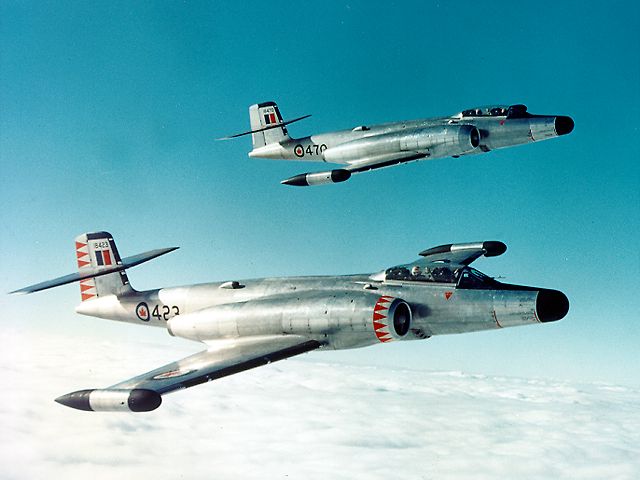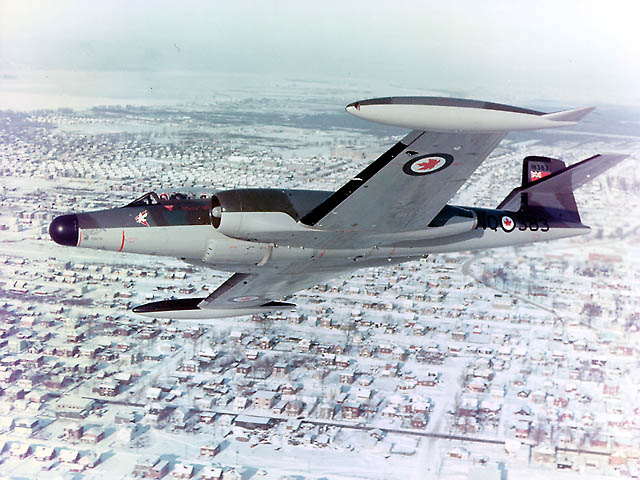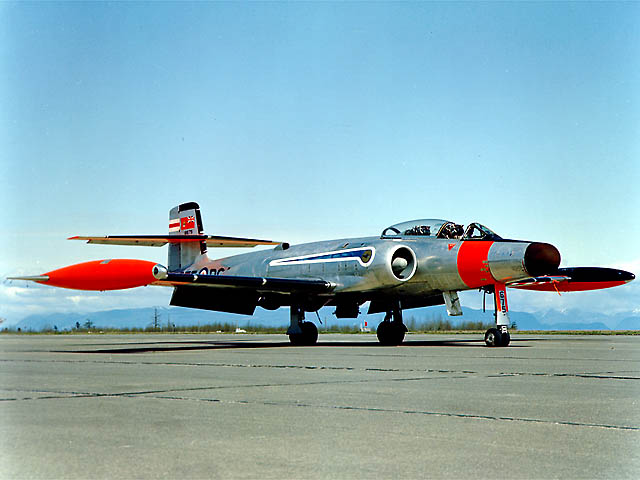 Museum
Museum  |
Bomber Command
|
Aircrew Chronicles
|
Aircrew Losses
|
Nose Art
|
BCATP
|
Lancaster
|
Media
|
Bomber Command
|
Aircrew Chronicles
|
Aircrew Losses
|
Nose Art
|
BCATP
|
Lancaster
|
Media
 Museum
Museum  |
Bomber Command
|
Aircrew Chronicles
|
Aircrew Losses
|
Nose Art
|
BCATP
|
Lancaster
|
Media
|
Bomber Command
|
Aircrew Chronicles
|
Aircrew Losses
|
Nose Art
|
BCATP
|
Lancaster
|
Media
Museum Collections
Aircraft in the Collection

|
The development, production, and operation of the CF-100 represents one of Canadian aviation's outstanding achievements. It remains the only Canadian designed and built combat aircraft to reach operational status and the "Canuck" played a critical role in this country's participation in the defence of North America and Europe during the first two decades of the Cold War. |
|
Following the defeat of Hitler, Canada's and the western world's attention became focused on the new threat posed by the Soviet Union. To play its part in the defence of North America, Canada needed a long range, all-weather interceptor capable of confronting the only threat seen at that time, Soviet bombers travelling across the Arctic Ocean carrying nuclear weapons. In 1946 Avro Canada began design work on a two seat, twin engined jet fighter and the first CF-100 flew in January, 1950.

The "Canuck" became operational in 1953 and continued flying with the Royal Canadian Air Force, and later the Canadian Armed Forces, until 1981. Both its role and weaponry changed through the years as some squadrons of CF-100's were based in Europe as part of NATO and the aircraft's armament evolved from machine guns to rockets and guided missiles.
In its prime, the "Canuck" was known as a rugged, dependable aircraft. One of the best all-weather fighters available, it served Canada, NORAD, and NATO well.

Glen "Robbie" Robinson is a member of the Nanton Lancaster Society and flew #18152, the museum's aircraft.
Of the CF-100 he wrote,
CF-100 #18152 was taken on strength by the Royal Canadian Air Force in May, 1953. It was one of a group of 70 designated as Mark 3's, all of which became two seat trainers with dual controls. Assigned to #3 Operational Training Unit, it was based at North Bay, Ontario and later at Cold Lake, Alberta and used to train aircrew to fly the more advanced Mark IV's and V's. In 1956, #18152 began service with 428 Squadron at Uplands, Ontario and then in 1958 it was transferred to #432 Squadron at Bagotville, Quebec. The aircraft was then reassigned to #3 O.T.U. from 1962 until 1964 following which it spent three years with the "Electronic Warfare Unit" based at St. Hubert, Quebec. #18152's last flight was in September, 1968 travelling to C.F.B. Suffield where it was involved in testing by the Defence Research Establishment.
In 1981, the aircraft was restored and placed on display as a "Gate Guardian" at the entrance to C.F.B. Suffield by the Experimental Model Shop, the Defence Research Establishment, and members of the Base. After being declared surplus to the needs of the Department of National Defence, it was acquired by the Nanton Lancaster Society in August, 1994.

CF-100 #18152 is now the "Gate Guardian" for the Nanton Lancaster Society Air Museum. The aircraft's markings are those of #3 O.T.U, with which it flew for the majority of its operational career, helping to train thousands of aircrew for the 692 CF-100's which were built by Avro Canada. An interesting connection with the Lancaster bomber is that the Orenda engines used to power the CF-100's were first tested on Lancaster FM 209.
The community of Nanton has a very special connection to the CF-100 through Bruce "Duke" Warren. Bruce and his identical twin brother Douglas were born in Nanton. They trained together in the BCATP and fought together flying Spitfires during the war and were both awarded the DFC.
Tragically, Bruce was killed in 1951 flying a CF-100 prototype. An investigation revealed a probable oxygen system failure. Douglas "Duke" Warren is a Lifetime member of the Nanton Lancaster Society and was Master of Ceremonies at the Bazalgette Dedication Ceremonies as well as our Grand Opening in 1992.

|
Engine: Wingspan: Length: Height: Maximum Weight: Empty Weight: Service ceiling: Maximum speed: |
two Orenda 8's, 6355 lbs. thrust each 52 ft. 52 feet 3 inches 14 ft. 6 inches 33 000 pounds 25 000 pounds 45 500 ft. 645 miles per hour |